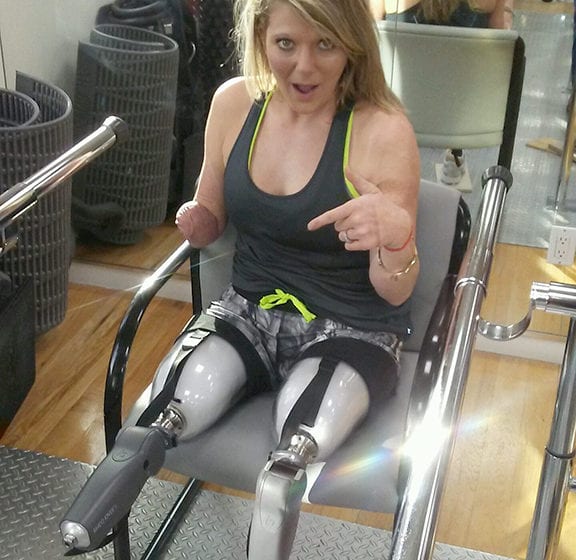
“Try not to let the physical difference define who you are. You are more than just your burn or amputation. You are proud, confident, smart, and interesting, and that’s what defines you.”
— Shelley Wiechmann, PhD, ABPP
It is this message that Shelley Wiechman, PhD, ABPP, imparts to her patients at the University of Washington Medicine Regional Burn Center in Seattle, where she is an associate professor of rehabilitation psychology. Wiechman helps people manage emotional and psychosocial aftereffects related to their recovery from burns, injuries, and resulting scars.
“Everyone has scars…whether emotional or physical,” shares 33-year-old Jessica Crumpton West, of Montgomery, Alabama. “Mine are just more visible.”
Crumpton West was severely burned five years ago when her uncle threw a pot of hot collard greens on her in an act of violence. She sustained burns on her arms, legs, chest, stomach, and face. Today, Crumpton West’s upbeat outlook is apparent as she jokes about how complications during one of her more than 200 surgeries could have easily ended her life.
“I died three times,” proclaims Crumpton West. “The last time, my heart stopped beating on its own for 48 hours. Justin, my husband of 13 years, had to decide what to do because doctors said I was most likely brain dead. Justin refused to give up on me, and now I always tell Justin I was only testing him to see if he loved me!”
Because her burns were so severe and the drugs that were used to treat her had cut off the circulation to her limbs, physicians were forced to amputate her legs above the knees and her right arm below the elbow to save her life. Crumpton West wears her scars proudly and finds humor in her day-to-day life as a wife and mother to three boys.
Humor Me
“One time a kid asked me where my legs were,” Crumpton West shares. “I told him they ran away, and I asked him if he would help me look for them. The boy reluctantly shook his head yes.” She continues, “Once when I was late to a speaking engagement at a church, I apologized and told the audience I was late because I couldn’t figure out which shoes to wear.”
“Having a good sense of humor helps in social situations,” says Wiechman. “With my patients, we work on self-esteem, showing pride and confidence, and we discuss how to present yourself to show that confidence. I tell my patients, ‘You might have to be the one to make the first move in a social situation so that you break the ice and let people know that you are okay.’”
Wiechman’s mission is to empower her patients to see beyond their scars with the hope that, in turn, those around them will do the same. “Making good eye contact, offering a smile first, starting a pleasant conversation, and also having a hobby or things to talk about—besides the accident or scars—helps in the rehabilitation process,” she explains.

Noticeable Reminders
“Scars remind us where we’ve been; they don’t have to dictate where we’re going,” shares Erik Schaffer, head prosthetist, founder, and CEO of A Step Ahead Prosthetics in Hicksville, New York.
“Visible scars can serve as a constant reminder to a patient,” explains Schaffer. “Imagine a patient who lost one leg and has extensive scarring on the other. Even if we’re able to make the artificial limb look perfectly natural by adding a custom silicone skin cover around the prosthesis, we can’t do the same with a scarred leg. The difference between the limbs can interfere with rehabilitation physically and also psychologically.”
Schaffer says crafting and fitting prostheses is only part of what a good prosthetist does. “We focus on the concept of being an ecosystem of support for our patients,” explains Schaffer, adding that the concept includes the one-to-one fittings, understanding the healthcare system, and psychosocial challenges patients may face. “Giving our patients the confidence they need to overcome their perceived limitations is a big part of what we do, along with the physical piece,” he adds.
Schaffer has firsthand knowledge of Crumpton West’s story because earlier this year his team fitted her prosthetic legs and helped her learn to walk for the first time in five years.
“Scarring can definitely affect how we approach a patient’s prosthetic care,” explains Schaffer. “Scar tissue can interfere with specific limb flexion and local stability, and in some cases, it can interfere with vacuum action due to irregular skin surface. Heavily scarred areas are often more susceptible to skin irritation and breakage that leads to pain, which in turn impacts one’s sense of confidence when stepping into a prosthesis. And that’s an important aspect of getting the most out of the device.”
Crumpton West says she doesn’t think much about the physical effects of her injuries—except for her breasts, which were badly burned but have recently been reconstructed. What she does know is that getting prostheses for her legs and learning to walk again has helped a great deal in her recovery.
“I am proud of who I am and how far I have come,” she says. “Some people don’t ever get a chance to walk. I did! And then I got a chance to relearn to walk on my robot legs. I am thankful and blessed. How many people get a second chance like me?”
Crumpton West says she recently got an adaptive van, which allows her more mobility to do what she loves—being mom: team mom, class mom, and carpool mom. She says she recently passed a one-handed typing test and hopes to go back to working outside the home soon.
“I am still me, just shorter,” she jokes. “It might take me a little longer, but I can do anything anyone else can.”

What Is ‘Visible’?
Wiechman has done some research to understand the concept of “visible” scars and asks, “At what point do you consider a scar ‘visible’? When it’s seen when wearing long sleeves? Short sleeves? Shorts? We have looked at ‘visible’ versus ‘hidden’ scars and have found that people with hidden scars take longer to adjust emotionally because they can hide their scars for longer. There is actually more shame associated with hidden scars. Intimacy can also be harder because people with scars that are more easily hidden often conceal their scars from a romantic partner in the beginning of the relationship. So, there is more stress and anxiety around when to reveal the scars and how their partner will respond.”
People deal with their injuries and visible scars in different ways, she says. “Research has shown that the importance people place on their appearance prior to their accident is the best predictor of how they will handle a change in physical appearance after their accident.”
“We also need the media to create more positive images and likable portrayals of people with visible scarring and physical differences in movies and on television,” she adds.
Schaffer agrees. “Scars serve as a constant reminder of a traumatic event,” he says. “Some people may carry them with a sense of survivor pride. We often see patients gaining more purpose and poise after they become amputees, as if the reminder of how fragile life is serves as a new base from which to restart.”
“Burn survivors, people with amputations, others with physical differences as a whole lead very productive lives and have a very high quality of life and satisfaction; however, the journey is much harder,” adds Wiechman.
Roll With It
Crumpton West agrees, offering words of wisdom to others facing similar challenges. “Sometimes it takes the bad to see all the good in the world. Keep your head up. Never give up on yourself, and you will be a stronger person because God has a plan. Maybe we can only see down a straight road, but he sees around the curves.” She adds, “Most importantly, enjoy every day. If you can’t make someone laugh, then life is not as much fun.”
Schaffer says having a mentor is a great way to help a new amputee with his or her recovery: “Many times, the simple gesture of introducing a patient to another in a similar condition has a deep, positive impact on their sense of confidence and acceptance.”
Crumpton West says she hopes to use her story to inspire others and to one day be a mentor, but for now, she says she’s “just rollin’ with it.”
— By Amy Di Leo, MS



